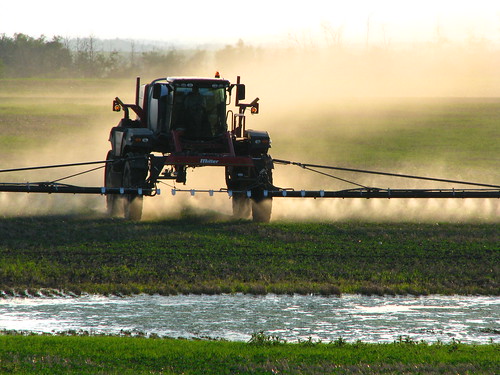 |
| Photo of crop spraying by TaminaMiller on Flickr |
The first GM plants with their single trait may have had a limited shelf-life, but they did serve a purpose. The lone genetic change they incorporate could be trivialised, giving minimal cause for alarm, and so regulation didn't become a big issue. In other words, they usefully paved the way for the next generation of GM crops. After single-trait crops came crops with multiple genetically 'stacked' traits. These should have presented a whole different regulatory ball-game, but they haven't.
'SmartStax' maize is now on the market. This GM crop has been genetically transformed to produce six different Bt-toxins and to tolerate two different herbicides. To the regulators, there's nothing new here, it's just that all the artificial traits are in one plant. Each of the novel genes has already been assessed (this doesn't mean 'tested') separately: no further information has been required.
The ease with which SmartStax has entered the food-chain is the result of a number of fostered beliefs regarding the nature of the artificial substances in GM plants.
So-called scientific 'wisdom' tells us that that Bt-toxin is a natural bacterial protein to which mankind has long been exposed without harm, and that Bt-toxin, like any other protein, will be broken down during digestion and disappear. Also, it tells us that Bt-toxin can bind only to insect cell membranes and therefore can only be harmful to insects. So, there's no need to test it ...
Scientific reality is rather different. Farmworkers using sprays of Bacillus thuringienses ('Bt') bacteria which produce natural forms of Bt-toxin were found to develop sensitivity to them. More significantly, the Bt-toxin generated by plants is chemically and functionally different from any natural form. Also, unlike bacterial Bt-toxins which are present as precursors, the artificial forms are produced in active form. Intact Bt proteins have been found circulating in the blood of mothers-to-be and their babies. A mounting body of evidence is linking Bt-feed to impairment of kidney function in test animals.
So-called scientific 'wisdom' has it that glyphosate herbicide passes through the body unchanged, and that its action is to interfere with a biochemical process only found in plants so that it can't possibly harm humans.
Scientific reality is that glyphosate has been linked to endocrine disruption, foetal deformation and DNA damage. Also, its unchanged form is an avid binder of trace metals vital to cell function in all living organisms, including man. Add to this that what people are exposed to is not just glyphosate but a commercial preparation, 'Roundup', in which glyphosate is the active ingredient, but which also contains a host of chemicals to promote the effectiveness of the herbicide.
(Note. The second herbicide-tolerance gene in SmartStax allows the crop to be sprayed with 'glufosinate'. This weed-killer is a recognised to cause reproductive harm and is scheduled to be banned in Europe)
What happens when the body finds itself assaulted by six Bt proteins and two herbicides all at once no one knows. However, some concerned scientists have, at last, made a start to find out.
The scientists chose human kidney cells for their experiments because of the suspected link between GM feed and kidney problems, and because these cells provide a sensitive model for the tissues which have to deal with toxins. The cultured cells were exposed to one of two Bt proteins in the activated form in which they are produced by GM plants; the cells were also exposed to each of the Bt proteins plus Roundup. Measurements were made of cell respiration, membrane integrity, and an indicator of the onset of death.
The conclusion of the study was that man-made Bt-toxins are not necessarily inert: at least one, Cry1Ab protein which is generated by MON 810 maize permitted for cultivation in the EU, can damage the mammalian cell-membrane, reduce cell respiration, and cause death of kidney cells at high concentrations. Further studies on the effects of chronic low-level exposure are needed. Roundup is toxic to kidney cell respiration at concentrations 200-fold lower than that used on GM crops. Both Bt proteins, even at low concentrations, exerted a protective effect against Roundup.
OUR COMMENT
One very disturbing aspect of this study is that, when the fostered assumptions are replaced with science, they can be blown apart. It's clear that Bt proteins, which now come in an infinity of man-made forms, are entirely unpredictable in their toxic potential.
The unexpected finding that Roundup's toxic effect can be changed by the presence of proteins isn't good news either: the proteins which are protecting cells from Roundup aren't available to do their job of protecting the cells from other toxins. Also, the potential toxicity of the Roundup may have been disguised by protein protection during previous 'safety' tests.
It is unacceptable to permit stacked GM-linked toxins into our food chain without careful testing of the effects of all combinations. Don't let the biotech industry get away with this outrageous use of fostered beliefs in lieu of science. Find out all about SmartStax maize at: http://www.i-sis.org.uk/SmartstaxMaizeAMedelyOFTransgenes.php
As a first step, encourage the UK government to support France in its demand for an EU-wide ban on MON 810 maize.
SOURCES
- R. Mesnage et al., 2012, Cytotoxicity on human cells of Cry1Ab and Cry1c Bt insecticidal toxins alone or with a glyphosate-based herbicide, Journal of Applied Toxicology, 2012
- Genetically engineered maize: New indication of health risks, Test Biotech CRIIGEN, 17.02.12
- Immune Responses in Farm Workers after Exposure to Bacillus Thuringiensis Pesticides, Environmental Health Perspectives, 107:7 July 1999
- Bt Toxin Kills Human Kidney Cells, Institute of Science in Society Report 14.03.12
- Bravo the French – ban GM maize, GM Watch, 14.02.12
No comments:
Post a Comment
Thanks for your comment. All comments are moderated before they are published.